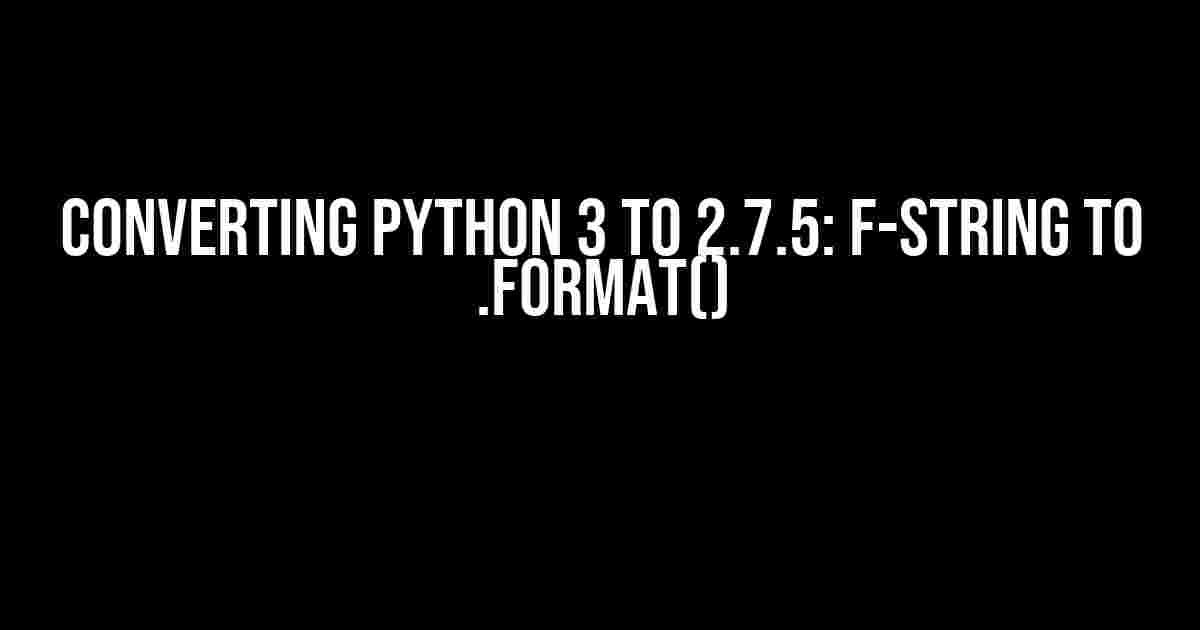Are you tired of struggling with the complexities of migrating your Python 3 code to Python 2.7.5? Do you find yourself stuck on the syntax of F-strings, wishing you could simply use the familiar .format() method? Well, fear not! In this comprehensive guide, we’ll walk you through the process of converting Python 3 F-strings to Python 2.7.5-compatible .format() syntax.
What are F-strings?
F-strings, also known as formatted string literals, are a feature introduced in Python 3.6. They provide a concise and expressive way to embed expressions inside string literals, using curly braces `{}`. The syntax is as follows:
f"My name is {name} and I am {age} years old."F-strings are a powerful tool, allowing you to format strings in a readable and efficient manner. However, if you need to support Python 2.7.5, you’ll need to convert these F-strings to use the .format() method instead.
Why Convert F-strings to .format()?
Python 2.7.5 does not support F-strings, which means that any code written using F-strings will not be compatible with this version of Python. If you need to support Python 2.7.5, you’ll need to convert your F-strings to use the .format() method, which is compatible with Python 2.7.5.
Advantages of Converting F-strings to .format()
- Backwards compatibility: By converting F-strings to .format(), you can ensure that your code is compatible with Python 2.7.5.
- Better support: .format() is a well-established method that has been supported in Python for a long time, making it a more reliable choice for Python 2.7.5.
- Faster execution: .format() is generally faster than F-strings, making it a better choice for performance-critical applications.
Converting F-strings to .format()
Converting F-strings to .format() is a relatively straightforward process. Here are the general steps:
- Replace the `f` prefix with an empty string.
- Replace the curly braces `{}` with `.format()`.
- Move the expressions inside the curly braces to the `.format()` method.
Let’s take an example. Suppose we have the following F-string:
f"My name is {name} and I am {age} years old."We can convert this to .format() as follows:
"My name is {} and I am {} years old.".format(name, age)Notice how we replaced the `f` prefix with an empty string, replaced the curly braces with `.format()`, and moved the `name` and `age` expressions inside the `.format()` method.
Converting Multiple F-strings
If you have multiple F-strings in your code, you’ll need to convert each one individually. For example:
f"My name is {name}."
f"I am {age} years old."Would become:
"My name is {}.".format(name)
"I am {} years old.".format(age)Common Issues and Solutions
When converting F-strings to .format(), you may encounter some common issues. Here are some solutions to these problems:
Issue 1: Expression Ordering
When using .format(), the expressions inside the method must be in the same order as the placeholders in the string. For example:
f"My name is {age} and I am {name} years old."Would become:
"My name is {} and I am {} years old.".format(age, name)Note how we swapped the order of `age` and `name` in the `.format()` method to match the order of the placeholders in the string.
Issue 2: Keyword Arguments
When using F-strings, you can pass keyword arguments using the `=` syntax. For example:
f"My name is {name=}"Would become:
"My name is %(name)s" % {"name": name}Note how we replaced the `f` prefix with an empty string, and used the `%` operator to format the string with keyword arguments.
Best Practices for Converting F-strings to .format()
When converting F-strings to .format(), it’s important to follow best practices to ensure your code is readable, maintainable, and efficient. Here are some tips:
- Use descriptive variable names to make your code more readable.
- Use consistent spacing and indentation to make your code more readable.
- Avoid using complex expressions inside the `.format()` method.
- Test your code thoroughly to ensure it works as expected.
Conclusion
Converting Python 3 F-strings to Python 2.7.5-compatible .format() syntax is a straightforward process that requires some care and attention to detail. By following the steps outlined in this guide, you can ensure that your code is compatible with Python 2.7.5 and runs efficiently. Remember to follow best practices and test your code thoroughly to ensure it works as expected.
| Python 3 F-string | Python 2.7.5 .format() equivalent |
|---|---|
| f”My name is {name}.” | “My name is {}.”.format(name) |
| f”I am {age} years old.” | “I am {} years old.”.format(age) |
| f”My name is {name=}.” | “My name is %(name)s” % {“name”: name} |
By converting your F-strings to .format(), you can ensure that your code is compatible with Python 2.7.5 and runs efficiently. Happy coding!
Frequently Asked Question
Are you tired of dealing with the hassle of converting Python 3 F-strings to Python 2.7.5’s `.format()` method? Well, you’re in luck! We’ve got the answers to your burning questions right here.
How do I convert a simple F-string to .format()?
To convert a simple F-string to `.format()`, simply replace the `f` prefix with `.format()` and use curly braces `{}` as placeholders for the variables. For example, `f”Hello, {name}!”` becomes `”Hello, {}!”.format(name)`. Easy peasy!
What about F-strings with multiple variables?
No problem! For F-strings with multiple variables, you can use `.format()` with multiple arguments. For example, `f”The answer is {answer} and the question is {question}!”` becomes `”The answer is {} and the question is {}!”.format(answer, question)`. Just make sure to pass the variables in the correct order!
How do I handle F-strings with formatting specifiers?
For F-strings with formatting specifiers, such as `f”The value is {value:.2f}!”`, you can use `.format()` with formatting specifiers as well. In this case, it would become `”The value is {:.2f}!”.format(value)`. The formatting specifier `:.2f` is applied to the `value` variable when formatting the string.
What about F-strings with expressions?
F-strings with expressions, such as `f”The result is {2 + 2}!”`, can be converted to `.format()` by evaluating the expression and passing the result as an argument. In this case, it would become `”The result is {}!”.format(2 + 2)`. Alternatively, you can use a variable to store the result of the expression and pass it to `.format()`. For example, `result = 2 + 2; “The result is {}!”.format(result)`.
Are there any tools to help with the conversion process?
Yes! There are tools available to help with the conversion process. One popular tool is `fstring_to_format`, a Python package that allows you to automatically convert F-strings to `.format()` method calls. You can install it using pip: `pip install fstring_to_format`. Additionally, some IDEs and code editors, such as PyCharm, have built-in features to help with the conversion process.



